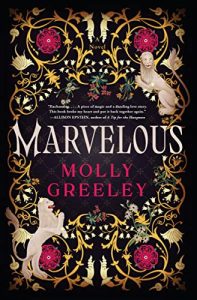Finding Marvelous
 In early 2020, I found Pedro Gonzales, the Wild Man of Tenerife. I was working with a friend in a café, and there he was, waiting—a snippet below one result from my Google search. The deadline for my second book’s edits loomed, and I’d been verifying a stray fact; what I found by chance instead was the possible origin for the French fairy tale “The Beauty and the Beast”—a rabbit hole into which I eagerly tunneled for the next several hours. I remembering turning to my friend to say, wonderingly, “I think I just found the subject for my next novel.”
In early 2020, I found Pedro Gonzales, the Wild Man of Tenerife. I was working with a friend in a café, and there he was, waiting—a snippet below one result from my Google search. The deadline for my second book’s edits loomed, and I’d been verifying a stray fact; what I found by chance instead was the possible origin for the French fairy tale “The Beauty and the Beast”—a rabbit hole into which I eagerly tunneled for the next several hours. I remembering turning to my friend to say, wonderingly, “I think I just found the subject for my next novel.”
Only a few weeks later, that café—and everything else—was shut down by the Covid-19 pandemic, and like so many others, I was left scrambling to find balance between work that needed to get done and the family life from which there was, suddenly, no break. I finished my edits while my kids fidgeted in their seats attending school remotely, and all the while the story idea that had found its way to me that afternoon in the café stayed at the back of my mind, waiting for me to return to it. That idea eventually became my third novel, Marvelous, about the Renaissance couple who may have inspired the fairy tale that, in turn, has inspired hundreds of adaptations.
#
We all know “Beauty and the Beast,” or at least some version of it: a prince angers a fairy and is transformed into a beast. A merchant caught in a storm picks a rose from the beast’s garden, and, for this crime, is sentenced to death by the beast. The merchant’s daughter, as beautiful as she is dutiful and good, agrees to live with the beast in exchange for her father’s life. The beast spends night after night asking her to marry him, only to be repeatedly refused, until finally—at the last possible moment—she realizes that under the beastly exterior lies a good man, a man she wants to marry. Her love transforms him back to his princely form and the two of them live—say it with me—happily ever after. It’s a story I have known and loved for most of my life.
The true story, though, is somewhat different.
If there is a stand-in for the wicked fairy, it was Catherine de’ Medici, the wife of the French Renaissance king Henri II and an avid collector of human marvels. If there was a “beast,” it was Pedro Gonzales, a ten year-old boy born covered in hair from head to toe, brought in a cage to the French court as a gift to the newly-crowned king. The beautiful girl was Catherine Raffelin, and she was, in fact, the daughter of a merchant, but beyond that we know almost nothing about her. Certainly not her feelings about being married off to a man as unusual as Pedro for the purpose of creating more hairy people to fill Catherine de’ Medici’s court.
The happily ever after, too, is an uncertain, nebulous thing, for although we have portraits of Pedro and Catherine and documents regarding their marriage and their births of their children (many of whom were indeed as hairy as their father), we have nothing at all to indicate the states of their minds or hearts.
#
Most of Marvelous was written in the afternoons, sitting cross-legged on the bed in our guest room while my two oldest kids played or worked just outside the door and my youngest napped upstairs. In the mornings, I was homeschooling—something I had never imagined I’d do. But afternoons, when my two year-old napped and my older kids worked independently, I locked myself away and immersed myself in the lives of my characters.
The pandemic had narrowed my physical world to the inside of our house. But writing Marvelous allowed me to journey the châteaux and palazzos of Renaissance France and Italy, the black sand beaches of Tenerife, and the slave markets of Portugal. At a time when my brain was buzzing with constant uncertainty, it was freeing to give myself over to the act of creation, to another time and place entirely.
It helped that I was giving myself over to a story that, since I was very small, had gripped my imagination and refused to let go (even before Disney’s version hit theaters, and despite the original’s problematic elements). And there was a strange symmetry to writing, in a time when all our lives were so circumscribed, about this particular real-life couple. I was privileged to be able to work from home, but I ached, also, for freedom of movement. Pedro and Catherine were at once protected and confined by the gilded cage of court life. Unlike the fairy tale, there was no magic waiting to release them from their confinement—neither the confinement of their carefully proscribed lives, nor the confinement that came from Pedro’s appearance.
For Pedro, of course, was never able to physically transform into anything other than himself. His hairiness was not result of a spell, but of a genetic condition known today as hypertrichosis.
#
I said earlier that we know little of the real Pedro and Catherine’s interior lives. We cannot know how much affection they had for one another. But I chose to have their arranged marriage turn, in Marvelous, into a partnership of equals, filled with the deep, messy, complicated love that builds over decades together. Because unlike the dutiful Beauty and the noble Beast, these were real people—complex and imperfect. But so-called imperfections—both external and internal—can be the most beautiful parts of a person to someone who loves them. In the end, these are often the parts we cherish most.
—
Though Molly Greeley earned a degree in English from Michigan State University, she spent a number of years working in cafes, law offices, and for insurance newspapers before finding the courage to write her first novel. Her work has been called “Intricate, masterly, and delightfully imaginative” (Library Journal), “Exquisite” (Austenesque Reviews), and “Nuanced” with a “hint of D.H. Lawrence” (BBC Culture). Her books have been Indie Next picks and have received starred reviews from Booklist and Library Journal.
She lives in northern Michigan with her husband and three children, and can often be found with her laptop at local coffee shops.
Twitter @MollyJGreeley
Website https://www.mollygreeley.com/
MARVELOUS
 “Enchanting. Molly Greeley has pulled off a piece of magic to tell a dazzling love story about the outcast’s ache to be cared for and belong. This book broke my heart and put it back together again.”–Allison Epstein, author of A Tip for the Hangman
“Enchanting. Molly Greeley has pulled off a piece of magic to tell a dazzling love story about the outcast’s ache to be cared for and belong. This book broke my heart and put it back together again.”–Allison Epstein, author of A Tip for the Hangman
“A richly detailed and imaginative novel. Readers will relish Greeley’s emotionally potent tale.”–Booklist
A mesmerizing novel set in the French royal court of Catherine de’ Medici during the Renaissance, which recreates the touching and surprising true story behind the Beauty and the Beast legend, from the acclaimed author of The Clergyman’s Wife and The Heiress.
1547: Pedro Gonzales, a young boy living on the island of Tenerife, understands that he is different from the other children in his village. He is mercilessly ridiculed for the hair covering his body from head to toe. When he is kidnapped off the beach near his home, he finds himself delivered by a slave broker into the dangerous and glamorous world of France’s royal court. There “Monsieur Sauvage,” as he is known, learns French, literature, and sword fighting, becoming an attendant to the French King Henri II and a particular favorite of his queen, the formidable Catherine de’ Medici. Queen Catherine considers herself a collector of unusual people and is fascinated by Pedro…and determined to find him a bride.
Catherine Raffelin is a beautiful seventeen-year-old girl whose merchant father has fallen on hard times and offers up his daughter to Queen Catherine. The queen will pay his debts, and his daughter will marry Monsieur Sauvage.
Catherine meets Pedro for the first time on their wedding day. Barely recovered from the shock of her father’s betrayal, she soon finds herself christened “Madame Sauvage” by the royal courtiers, and must learn to navigate this strange new world, and the unusual man who is now her husband.
Gorgeously written, heartbreaking and hopeful, Marvelous is the portrait of a marriage, the story of a remarkable, resilient family, and an unforgettable reimaging of one of the world’s most beloved fairy tales.
BUY HERE
Category: On Writing
























